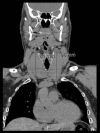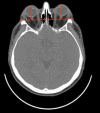Use of Adjunctive Therapy to Achieve Preoperative Euthyroidism in Graves' Disease: A Case Report
- PMID: 32759886
- PMCID: PMC7431014
- DOI: 10.12659/AJCR.923342
Use of Adjunctive Therapy to Achieve Preoperative Euthyroidism in Graves' Disease: A Case Report
Abstract
BACKGROUND Graves' disease is an autoimmune disease of the thyroid gland and it is considered the most common cause of hyperthyroidism. It is characterized by particular eye manifestations, skin changes, and pretibial myxedema in addition to the signs and symptoms of hyperthyroidism. Graves' disease can be diagnosed based on clinical presentation and low thyroid stimulating hormone (TSH) and elevated free T4 (FT4) levels. Presence of TSH receptor antibody (TRAb) in the serum confirms the diagnosis of Graves' disease. Imaging studies like radioactive iodine scan will show a high and diffuse uptake. Graves' disease can be managed with three different treatment modalities: antithyroid medications, radioactive iodine, or surgical removal of the thyroid gland. Whenever surgery is indicated, careful preoperative management to achieve euthyroidism is needed to optimize the surgical outcome. CASE REPORT This is a case of a 37-year-old Saudi male known to have Graves' disease for 2 years who presented to the endocrine surgery clinic with neck swelling, difficulty breathing, and change in voice. After multiple attempts to control his fluctuating thyroid levels, the team eventually managed to achieve a euthyroid state in the patient with the addition of saturated solution of potassium iodide (SSKI), and thus rendering him eligible for urgent surgery. CONCLUSIONS We report this case to show that SSKI can be used as adjunctive therapy to achieve a preoperative euthyroid state in refractory Graves' disease.
Conflict of interest statement
Figures




References
-
- Pokhrel B, Bhusal K. In: Graves disease. StatPearls, editor. Treasure Island (FL): StatPearls Publishing; 2020. - PubMed
-
- DeGroot LJ. In: Graves’ disease and the manifestations of thyrotoxicosis. Feingold KR, Anawalt B, Boyce A, et al., editors. Endotext South Dartmouth (MA): MDTextcom, Inc; 2000.
-
- Subekti I, Pramono LA. Current diagnosis and management of Graves’ disease. Acta Med Indones. 2018;50(2):177–82. - PubMed
Publication types
MeSH terms
Substances
LinkOut - more resources
Full Text Sources
Medical

